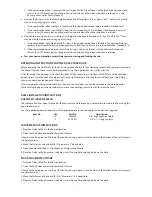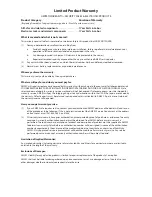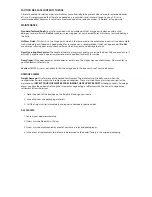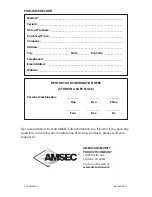
Each AMSEC safe is professionally hand-crafted with quality materials and is equipped with a precision-quality,
high-security combination lock. To become familiar with the lock, operate the lock (as outlined below) several times
before closing the door and locking the safe.
Operating instructiOns fOr the esL5 eLectrOnic safe LOck
Your AMSEC ESL5 Electronic Safe Lock has a Factory Combination of c-1-2-3-4-5-6-#
To open the lock, simply press the “C” key to clear and wake up the electronics. Now press the keys of the combination
one at a time and finish with the “#” key. If the combination keyed is correct, the lock will cycle open for three (3)
seconds. During this 3 second period, turn the handle of the safe to the unlocked position and pull the door open.
You may change your combination any time you like, and as many times as you like. Once your safe is installed, you
must change the combination to a number sequence other than the Factory Combination of 1-2-3-4-5-6 to insure the
safety of your valuables.
here are a few things to remember:
a. With each keystroke the keypad lights will flash off and a chirp will be heard, unless Stealth Mode is on, then no
sounds are emitted during lock opening.
b. If 4 (four) incorrect combinations are entered, the lock will go into a “Penalty Lockout” for 15 minutes to prevent
trial and error manipulation attempts at opening the lock. The keypad will flash once every 5 seconds during the
penalty period. If you press any key during the lockout period, the keypad will flash with a chirp 8 times rapidly to
indicate the lockout condition.
c. Before keying the combination, be sure that the handle of the safe is in the fully locked position to allow the lock
to open freely.
d. If the lock fails to open or acts strange, replace the battery with a good quality fresh 9 volt alkaline battery. To
replace the battery, simply turn the keypad housing counter-clockwise to the stop and pull it away from the base.
Un-snap the old battery and clip on the new one. Position the battery it in the pocket of the housing and replace
the keypad, watching that the wires fold neatly inside and are not pinched. You should replace your battery once a
year to prevent corrosion damage from leakage.
e. During the input sequence, if you make a mistake, you can press “C” to clear the previous input and start over again.
f. The ESL5 uses a fixed length 6 (six) digit combination.
g. Use only your fingers to key the combination. Sharp objects will result in damage which is not covered by
warranty.
h. If at any time during opening, or combination changing, the unit is left without input for 10 (ten) seconds, it
returns to a resting condition. If this occurs during a combination change, the Old Combination is retained.
i. At any time during opening or combination changing the unit will register the first 5 digits of the combination
into the “buffer” that receives input. The 6th digit will be the last numeric key pressed. For example, if your press
c-1-2-3-4-5-7-4-5-2-7-6-# the program recognizes only the C-1-2-3-4-5-6-# input. The last numeric key pressed
continues to replace the one prior until the “#” key is pressed to indicate completion. This is a security feature that
allows you to baffle an on-looker that may be trying to memorize your combination.
Quiet Mode –silent Operation
The ESL5 Lock provides a Stealth Mode you can program so the Beeper remains silent during normal lock opening
operation. To turn Stealth Mode ON (silent) or OFF (beeping):
On: Press C-# (short warble tone), then 8-0-# (short warble), then 1-# (long warble).
Off: Press C-# (short warble tone), then 8-0-# (short warble), then 0-# (long warble).
combination changing instructions for the esL5 electronic safe Lock
-- cautiOn --
combination changes should always be done with the door locked Open.
to change the combination, do the following:
a. Press the keys “C” and then “#”. The unit responds with a short warbling tone (called the “good combo tone”) and
the keypad lamps strobe with the tone.
b. Now key in the old 6 digit combination. The “C” key may be used to clear an error in keying at any time. Finish the
input with a “#” key.
1. If the old combination keyed matches the existing combination in permanent memory, another short good
combo tone is sounded. Proceed to “c.”















